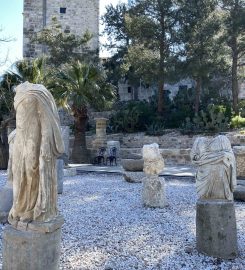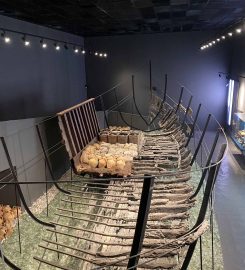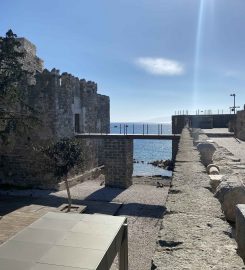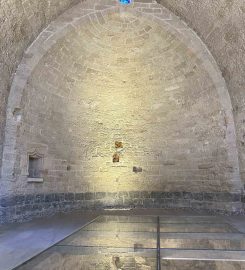Bodrum Castle Claimed
Museum of Underwater Archaeology
Bodrum Castle – St. Peters Castle – Museum of Underwater Archaeology
Bodrum castle built by the Knights Hospitaller in the 15th century and dedicated to St. Peter. Today Castle houses the Museum of Underwater Archaeology (Sualtı Arkeoloji Müzesi). Arguably the most important museum of its type in the world. And a veritable lesson in how to bring ancient exhibits to life. Items creatively displayed and well lit, and information panels, maps, models, drawings, dioramas and videos all help to animate them.
Based on Rhodes, the Knights Hospitaller built the castle during Tamerlane’s Mongol invasion of Anatolia in 1402. They weakened the Ottomans and gave the order an opportunity to establish a foothold here. They used marble and stones from Mausolus’ famed Mausoleum. It had collapsed in an earthquake, and changed the city’s name from Halicarnassus to Petronium, recalling St.Peter. By 1437 they had finished building, although they added new defensive features (moats, walls, cisterns, etc.) right up until 1522, when Süleyman the Magnificent captured Rhodes. The Knights forced to cede the castle, and the victorious Muslim sultan promptly turned the chapel into a mosque, complete with new minaret. For centuries, the castle never tested, but French shelling in WWI toppled the minaret (re-erected in 1997).
Spread around the Bodrum castle, the attractively lit and informative museum reconstruction and multimedia displays to complement the antiquities. It gets very busy and claustrophobic in the museum’s small rooms, so try to arrive early. Look to the ground for green/red mosaic arrows indicating a short/long tour route. You’ll see peacocks strolling, strutting and calling to prospective mates throughout the castle grounds.
Main Court
Beyond the ticket booth, you’ll pass carved marble Crusader coats of arms – just some of the 250-odd here. At the top of a flight of steps and through a gate is the castle’s main courtyard, centred on an ancient mulberry tree. Here is a massive amphorae collection, with pieces from the 14th century BC to modern times, all recovered from southern-coast waters.
On the east side of the courtyard is the chapel (1406) containing a full-sized reconstruction of a late-Roman ship’s stern that sank off Yassıada in AD 626. Walk the decks, take the helm and inspect the galley and amphorae below.
Climbing towards the towers to the east, you next come to the Glass Wreck Hall on the left. It houses a 15m-long, 5m-wide ship that sank near Marmaris in AD 1025, while carrying 30 tonnes of glass between Fatimid Syria and a Byzantine glass factory on the Black Sea or the Danube. Archaeologists and historians excited not only by what the find revealed about 11th-century ship construction – some 20% of it is on display. But also for what it indicated about Fatimid glass production and design.
Next, the small Glass Hall exhibits finds from the 15th century BC to the 14th century AD. It includes Mycenaean beads, Roman glass bottles and Islamic weights.
French Tower & Carian Princess Hall
A slight distance to the north, the French Tower has finds from the Tektaş Burnu, the world’s only fully excavated classical Greek shipwreck (dating from 480 BC to 400 BC). Amphorae, talismanic marble discs and kitchen utensils from the vessel displayed, plus 2001 excavation photos taken at the Çesme Peninsula site. Ancient coins (including from Croesus’ Caria) and jewellery are also on display.
The neighbouring Carian Princess Hall is a must-see, exhibiting a gold crown, necklace, bracelets, rings and an exquisite wreath of golden myrtle leaves. Popularly associated with the last Carian queen, Ada (Mausolus’ sister who reinstated by Alexander the Great after annexing Halicarnassus in 334 BC). They belonged to an unknown woman of status whose skeleton found in the heavy terracotta sarcophagus on display here.
English Tower
Guarding the castle’s southeast corner, the three-storey English Tower, also known as the Lion Tower, was built during the reign of King Henry IV of England (1399–1413). In 1401 Henry became the first (and only) English monarch to host a Byzantine emperor, Manuel II Palaeologos. And he took seriously Manuel’s warning about the Muslim threat posed by the Turks to Christian Europe. The tower was thus a symbol of support for their common cause.
Today, the interior is fitted out as a slightly kitsch medieval refectory, with a long dining table surrounded by suits of armour. Stag horns, lions’ heads and the standards of the Knights Hospitaller and their Turkish adversaries. Most interesting is the model of the Sovereign of the Seven Seas, a ship built on Charles I’s orders in 1637. And the graffiti in Latin carved into much of the walls 500 years ago by the Knights Hospitaller.
Bronze Age Shipwrecks Hall
Just opposite the English Tower is this hall containing three Bronze Age shipwrecks. Including the world’s oldest excavated wreck, the 14th-century BC Uluburun. Its sank 8km off the coast near Kaș. Full-size replicas of the booty-laden hold and the wreck site on the sea floor are in place. The adjoining Treasure Room displays Canaanite gold jewellery, bronze daggers, ivory cosmetic boxes, wooden writing boards. And Egyptian Queen Nefertiti’s golden scarab found on a wreck and already several hundred years old by then.
Gatineau Tower & Snake Tower
Turn left out of the hall to follow the battlements around the castle to the dungeons at Gatineau Tower, where the Knights imprisoned, and sometimes tortured, their enemies from 1513 to 1523. The inner gate’s chilling inscription sums up the dungeon as being Inde Deus abest (Where God does not exist). Hold children’s hands and mind your head – the 24 steps down are steep and narrow. En route you’ll pass three uncomfortable-looking garderobes – outdoor medieval toilets.
On the way back to the exit, the Snake Tower displays more artefacts and statuary. Named after a snake carved in the stone, it used as a hospital by the Knights and later the Ottomans.
Now days, Bodrum Castle closed for reconstruction and just a part open for visitors.
1 Review for Bodrum Castle
It’s a pretty generic castle, but it becomes way more interesting in context. I recommend reading up and visiting the mausoleum first. Also, best to go before noon because all the stone gets really hot and the whole place becomes an oven with a lot of very tall steps.

 Русский
Русский







